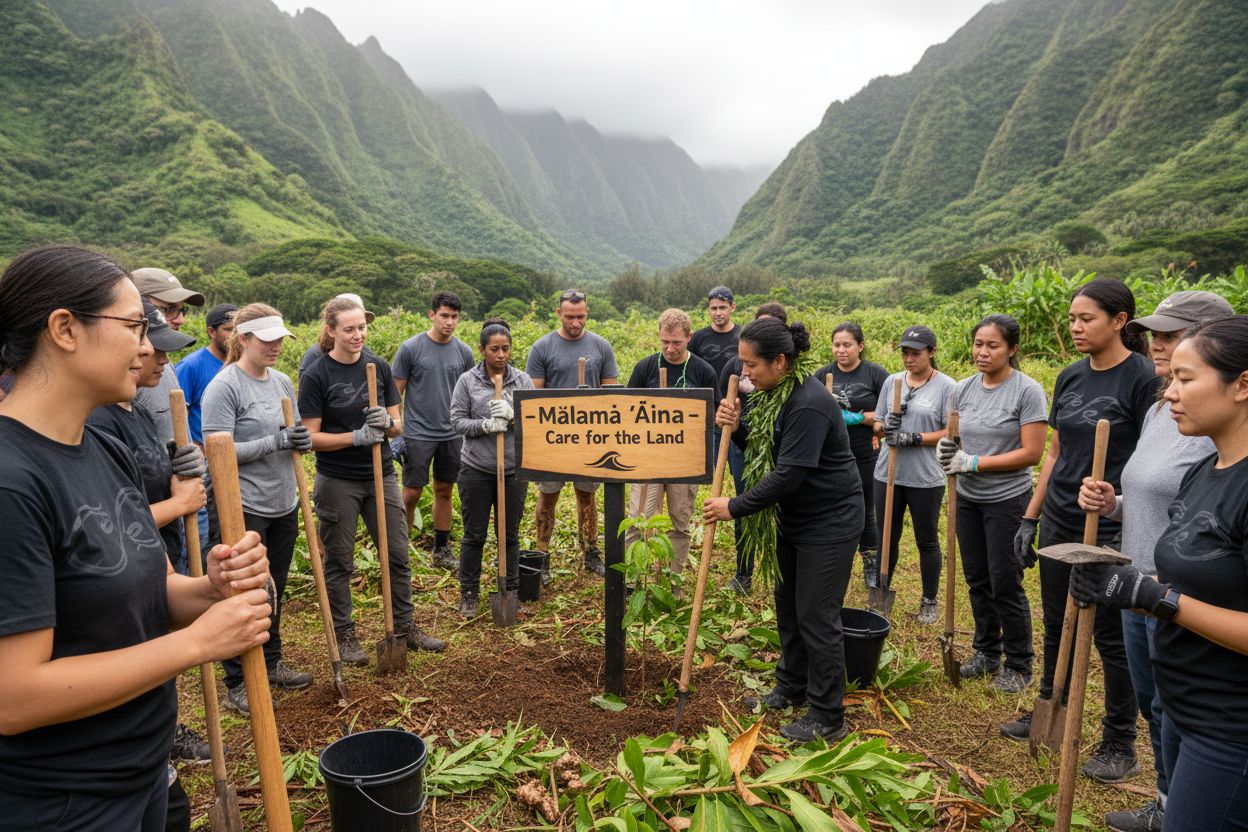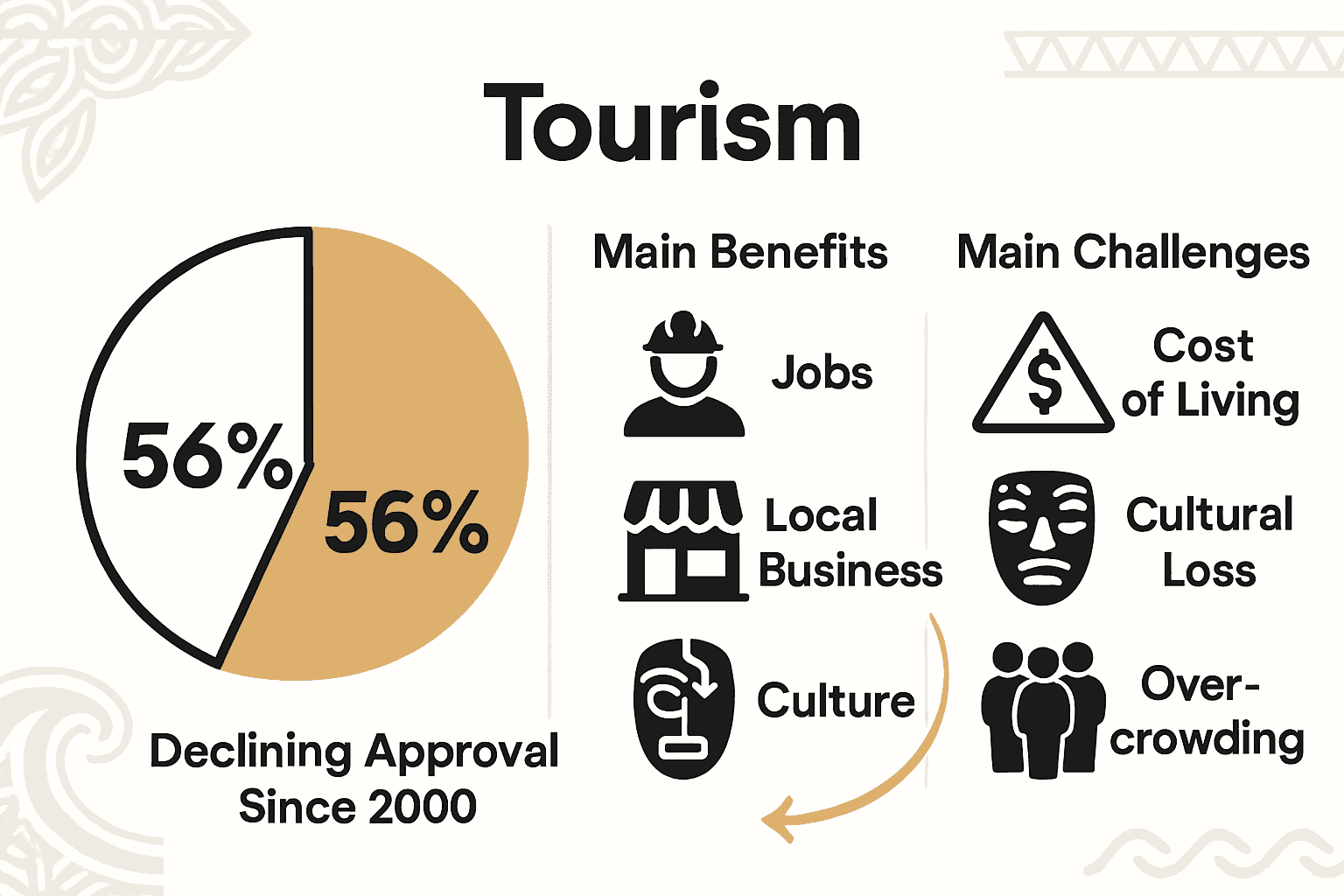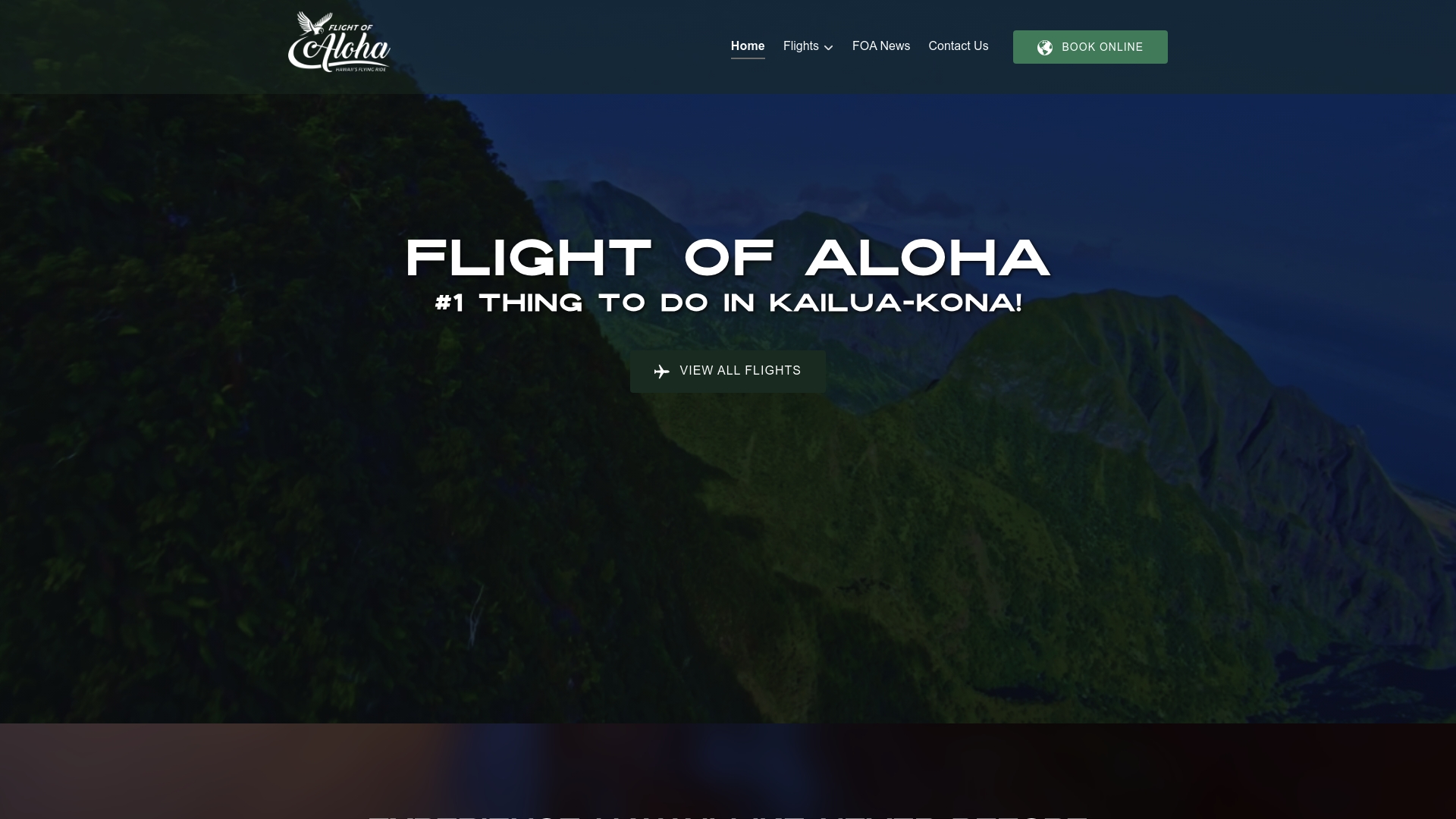Complete Guide to Hawaiian Community Engagement in Tourism

Only about 56 percent of Hawai’i residents now believe tourism brings more good than harm, marking a sharp change from previous years. This growing concern highlights how vital it is to honor Hawaiian culture, protect natural resources, and involve local voices in every tourist experience. A closer look at Hawaiian community engagement reveals how meaningful partnerships and respect for tradition can shape tourism that gives back to residents as much as it attracts visitors.
Key Takeaways
| Point | Details |
|---|---|
| Cultural Integrity | Hawaiian community engagement in tourism emphasizes cultural respect and preservation as fundamental principles. |
| Community Benefits | Residency surveys indicate a decline in perceived tourism benefits, highlighting the need for direct community advantages over economic gains. |
| Environmental Stewardship | Protecting natural resources is crucial, requiring balanced tourism models that prioritize ecological integrity. |
| Local Empowerment | Innovative initiatives empower residents to share their culture authentically, transforming tourism into meaningful exchanges rather than mere transactions. |
Table of Contents
- Defining Hawaiian Community Engagement In Tourism
- Types Of Community Participation Initiatives
- Key Principles Guiding Engagement Efforts
- Benefits And Challenges For Local Residents
- Best Practices And Real-World Examples
Defining Hawaiian Community Engagement in Tourism
Hawaiian community engagement in tourism represents a nuanced partnership between local residents, cultural practitioners, and visitors that goes far beyond simple economic transactions. At its core, this approach seeks to transform tourism from a transactional experience into a meaningful cultural exchange that respects and preserves Hawaiian traditions, values, and landscapes.
According to research from the University of Hawai’i Economic Research Organization, the relationship between residents and tourism is complex and evolving. By spring 2024, only 56% of Hawai’i residents agree that tourism brings more benefits than problems – a significant drop from over 70% in the early 2000s. This shift reveals a critical insight: community engagement is no longer just about economic opportunity, but about maintaining cultural integrity and environmental respect.
True Hawaiian community engagement in tourism involves several key principles:
- Cultural Respect: Prioritizing authentic representation over commodification
- Economic Fairness: Ensuring local communities directly benefit from tourism revenues
- Environmental Stewardship: Protecting natural resources and sacred spaces
- Educational Exchange: Creating opportunities for genuine cultural understanding
For those seeking deeper insights into this nuanced relationship, understanding Hawaiian tradition in tourism provides valuable context about how cultural practices can be respectfully integrated into visitor experiences.
Types of Community Participation Initiatives
Community participation in Hawaiian tourism has evolved into a sophisticated ecosystem of targeted initiatives designed to empower local residents and preserve cultural heritage. In 2024, the Hawai’i Tourism Authority (HTA) demonstrated significant commitment by funding five strategic community engagement programs that directly support local nonprofit organizations and community groups across the state.
These initiatives represent a comprehensive approach to community involvement.
 According to HTA data, the five key programs include:
According to HTA data, the five key programs include:
Here’s a summary of the five key community participation initiatives in Hawaiian tourism:
| Program Name | Focus Area | Main Goal |
|---|---|---|
| Kahu ʻĀina | Land stewardship Environmental care |
Protect ʻāina and natural resources |
| Kūkulu Ola | Cultural preservation | Support traditional cultural practices |
| Resort Area Hawaiian Culture | Cultural integration in resorts | Offer authentic experiences at destinations |
| Community Enrichment | Local development | Fund projects that benefit communities |
| Signature Events | Cultural celebrations | Highlight significant community events |
- Kahu ʻĀina: Focusing on land stewardship and environmental protection
- Kūkulu Ola: Preserving and promoting traditional Hawaiian cultural practices
- Resort Area Hawaiian Culture Initiative: Integrating authentic cultural experiences within tourism destinations
- Community Enrichment: Supporting local community development projects
- Signature Events: Highlighting and funding culturally significant community celebrations
Two groundbreaking collaborative programs have emerged as particularly innovative. The Community Stewardship Program provides targeted funding and capacity-building for ʻāina-based stewardship organizations, while the Regenerative Experiences Program supports creating sustainable visitor experiences that foster reciprocal relationships between residents, visitors, and the land. These initiatives represent a transformative approach to tourism that prioritizes community well-being and cultural preservation.
For visitors interested in understanding the deeper cultural context of these initiatives, understanding Hawaiian culture in modern entertainment offers additional insights into how Hawaiian traditions are respectfully integrated into contemporary experiences.
Key Principles Guiding Engagement Efforts
Hawaiian tourism engagement is guided by a profound commitment to cultural preservation, community empowerment, and sustainable development. The Hawai’i Tourism Authority (HTA) has established a comprehensive framework that goes beyond traditional tourism approaches, emphasizing regenerative principles that prioritize the well-being of local communities and the preservation of cultural heritage.
According to HTA’s strategic initiatives, the key principles driving community engagement are rooted in two foundational programs: the Aloha+ Challenge and ʻĀina Aloha Economic Futures. These programs represent a transformative approach that reinvests tourism revenue directly into local culture, natural resources, and community development. The core principles include:
- Cultural Perpetuation: Ensuring Hawaiian language, traditions, and cultural practitioners remain central to visitor experiences
- Community First: Prioritizing local community benefits over pure economic gain
- Sustainable Stewardship: Protecting natural resources and supporting ecological balance
- Reciprocal Relationships: Creating meaningful exchanges between visitors and local residents
- Economic Resilience: Developing tourism models that support long-term community prosperity
The Hoʻokipa Malihini and Kūkulu Ola programs exemplify these principles by directly funding initiatives that preserve and celebrate Native Hawaiian culture. These efforts transform tourism from a transactional industry into a platform for cultural understanding and mutual respect.
For travelers seeking a deeper understanding of these principles, understanding Hawaiian tradition in tourism offers valuable insights into the nuanced approach of Hawaiian community engagement.
Benefits and Challenges for Local Residents
The landscape of community tourism in Hawai’i is a complex tapestry of opportunities and concerns, reflecting the nuanced experiences of local residents. While tourism brings significant economic advantages, it simultaneously presents challenges that deeply impact community well-being and cultural preservation.
According to recent surveys, the economic benefits of tourism are clear: local businesses receive critical support, and job creation remains a substantial positive outcome. However, the research reveals a more complicated narrative. A striking 75% of residents cite cost of living as the most prominent tourism-related issue, indicating that economic gains are not evenly distributed across the community. Additionally, 69% of residents express significant concerns about cultural disrespect and environmental pressures on the ʻāina (land).
The key benefits and challenges for local residents include:

Benefits:
- Job creation across multiple sectors
- Support for local businesses
- Infrastructure development
- Cultural exchange opportunities
- Economic reinvestment in communities
Challenges:
- Escalating cost of living
- Cultural commodification
- Overcrowding in residential areas
- Environmental stress on natural resources
- Potential displacement of local communities
Navigating these complex dynamics requires a delicate balance between welcoming visitors and protecting community interests. For deeper insights into how Hawaiian communities are addressing these challenges, understanding Hawaiian tradition in tourism offers valuable perspectives on maintaining cultural integrity within the tourism ecosystem.
Best Practices and Real-World Examples
Hawaiian community engagement in tourism requires a thoughtful, deliberate approach that transforms traditional visitor interactions into meaningful cultural exchanges. Authentic engagement goes beyond surface-level experiences, creating opportunities for genuine understanding and mutual respect between visitors and local communities.
Several innovative practices have emerged as powerful models for community-centered tourism:
- Cultural Ambassador Programs: Training local residents to share authentic stories and traditions
- Community-Guided Tours: Experiences directly managed and narrated by Native Hawaiian practitioners
- Revenue Sharing Mechanisms: Ensuring tourism income directly supports local community projects
- Visitor Education Initiatives: Providing meaningful context about Hawaiian culture and environmental stewardship
- Sustainable Tourism Workshops: Teaching visitors about responsible travel practices
Successful implementation often involves creating structured frameworks that prioritize community leadership and cultural preservation. This might include developing tourism experiences that are co-created with local communities, implementing strict cultural sensitivity guidelines, and establishing economic models that provide direct benefits to indigenous practitioners.
For travelers interested in experiencing these principles in action, understanding Hawaiian culture in modern entertainment offers additional insights into respectful cultural engagement.
Experience Hawaiian Community Engagement Firsthand With Flight of Aloha
Are you searching for a deeper, more meaningful way to connect with Hawaiian culture—one that respects local traditions, supports real communities, and inspires responsibility for the land? The challenges shared in this guide, from cultural commodification to a need for authentic exchanges, are at the heart of why Flight of Aloha exists. Here, every immersive flight is an invitation to experience the spirit of aloha through powerful visuals, sounds, and stories rooted in genuine Hawaiian tradition. Our unique Flight of Aloha attraction does more than entertain—it creates a lasting bridge between visitors and the vibrant culture of Hawai’i.

Choose to go beyond traditional tourism. Book your immersive cultural experience now and feel what it truly means to be welcomed as a guest who honors local stories and stewardship. Turn the insights from this complete guide into real-life action and join us for a journey that uplifts Hawaiian community engagement in every sense. Secure your tickets today at Flight of Aloha and become part of Hawaii’s living story.
Frequently Asked Questions
What is Hawaiian community engagement in tourism?
Hawaiian community engagement in tourism refers to collaborative efforts between local residents and visitors that aim to promote cultural exchange and preserve Hawaiian traditions and values while ensuring economic benefits for the community.
What are the key principles guiding community engagement in Hawaiian tourism?
The key principles include cultural perpetuation, community-first focus, sustainable stewardship, reciprocal relationships, and economic resilience, all aimed at fostering mutual respect and benefits between visitors and local residents.
What are the benefits and challenges of tourism for local residents in Hawaii?
Benefits include job creation, support for local businesses, infrastructure development, and cultural exchange opportunities. Challenges encompass rising costs of living, cultural commodification, overcrowding, environmental stress, and potential displacement of communities.
How does Hawaiian tourism integrate cultural practices into visitor experiences?
Hawaiian tourism integrates cultural practices through initiatives such as cultural ambassador programs, community-guided tours, revenue sharing mechanisms, visitor education initiatives, and sustainable tourism workshops, ensuring authentic and respectful engagement with local culture.
